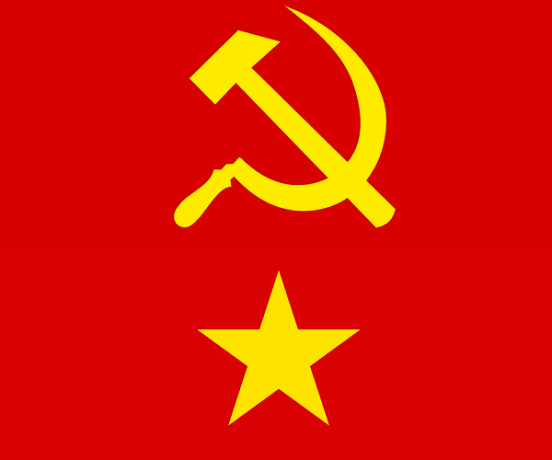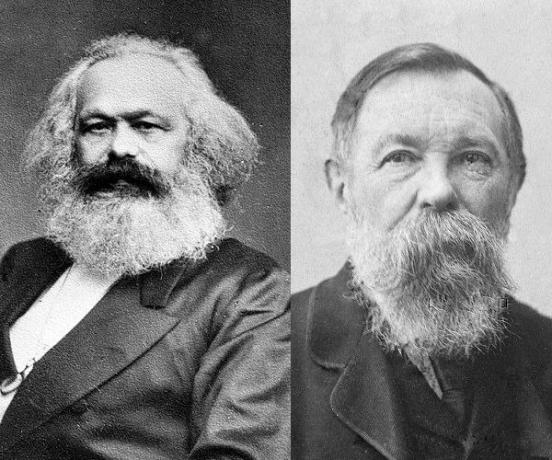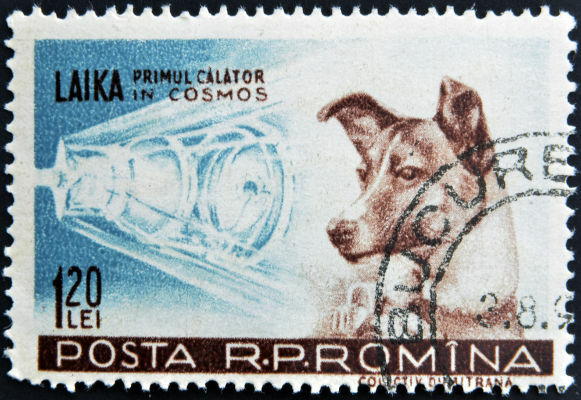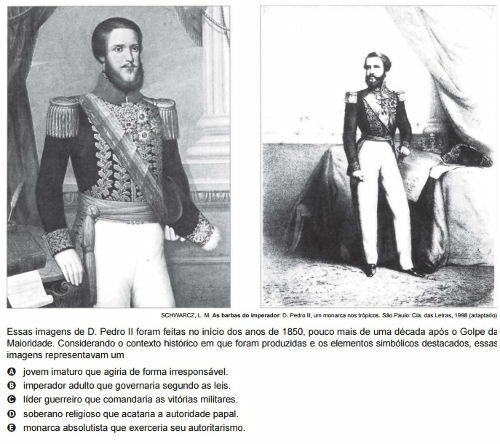Communism is a social doctrine whose aim is to re-establish what is called the "natural state" in which all people would have the same right to everything, through the abolition of private property and the end of class struggle. In the 19th and 20th centuries the term was used to qualify a political movement.
This word comes from Latin communes, which means common. Being a communist means agreeing with the ideas of Karl Marx and Friedrich Engels and defending the changes political, economic and social necessary to overcome the capitalist society by a society without classes.
Main characteristics of communism
The main features of the communist doctrine are:
- collectivization of the means of production;
- the result of what is produced is shared among all members of society;
- production must be just enough for the maintenance of society;
- there is no concept of private property;
- abolition of the state and national borders (communism is internationalist).
Learn more about characteristics of communism.
Differences between Communism and Socialism
The expressions communism and socialism are often used interchangeably, which is not correct. However, the two concepts represent ideologies with some similarities, as they represent a form of protest or a alternative to capitalism.
Many pro-communist authors describe socialism as a step towards communism, that would organize society differently, eliminating social classes and extinguishing the state oppressor.
The way in which communism and socialism works is also different. While socialism foresees a gradual change in society and a move away from capitalism, communism intended a sharper differentiation and often using armed conflict as a method of acting.
See the meanings of Socialism, scientific socialism, Marxist Socialism and meet 7 characteristics of socialism.
How did communism come about?
Communism has its foundation in the theories of the state of the Greek sophists and in the work "The Republic" by Plato. Ancient Greece foresaw the formation of a society in which social classes would not exist. But this idea met with severe critics such as Aristotle very early on.
Communism continued to make itself felt in many movements thereafter, such as Thomas Münzer and the Anabaptists in Puritan sects in North America in the 17th and 18th centuries.
It is in this period, specifically in the 18th century, that the Enlightenment begins. Despite being an intellectual movement led and organized by the bourgeoisie, it continued to criticize private property, through authors and thinkers such as Jean-Jacques Rousseau, in France.
The great revival of communism or socialism at the beginning of the 19th century is related to the Industrial Revolution.
The abuses of capitalism and economic liberalism, committed by the transformation of the economy and industry, provoked a critical movement that, in many cases, is related to the ideas communists.
Symbols of Communism

The sickle, hammer and five-pointed star are symbols of communism, used universally. The sickle represents the workers in the field and the hammer represents the workers in the industries.
The five-pointed star can represent the five continents of the world. Another theory explains that the star represents the groups that make up communist society: workers, rural workers, intellectuals, youth and the army.
The red background used in all communist symbology, on the other hand, is linked to the representation of the ideal of revolution in communism.
Many communist countries adopted the use of these symbols on their official flags, such as China, Vietnam, North Korea and Angola.
modern communism
Modern communism expresses itself primarily as a doctrine through the Marxism, later on Marxism-Leninism and partly also in Marxist Maoism. It is fundamentally a doctrine aimed at the equality of the majority.
According to Karl Marx and Friedrich Engels, 20th century communism regards history as a succession of struggles between the working class and the bourgeoisie. Both are authors of the work Communist Party Manifesto, of 1848.
According to the two authors, the bourgeoisie does not work and if they do it is insignificant, but they have the material means of production. For its part, the proletariat has nothing but its offspring (the children), hence its name.
In this way, the proletariat must sell its labor power to the bourgeoisie in order to guarantee its livelihood.
See the meaning of Marxism.
Communist Party Manifesto
The Communist Manifesto was published in 1848. It was written by Karl Marx and Friedrich Engels, considered the founders of scientific socialism. In the document, the main communist ideals are presented and the forms of socialism are described and analyzed: reactionary, conservative and utopian.
The manifest is a criticism of the way society was organized around capitalism.
The work contains criticisms of the bourgeoisie as an oppressive social class, mainly in relation to the organization of society in the post-Industrial Revolution period.
The manifesto also presents the existing differences between the bourgeois and working classes (proletariat) and the relationship between the proletariat and the parties of the time.
One of the objectives of the manifesto is to demonstrate that the working class is able to unite to revolutionize and change its situation as a class oppressed by capitalist ideas and bourgeois society.
The manifesto defends ideas such as:
- end of private ownership of land,
- end of inheritance rights,
- delivery of the means of production to State control.

Karl Marx and Friedrich Engels
What is the historical view of Marxism?
The communist authors claim that man's living conditions (mainly economic) determine his conscience.
Thus, he considers that the development of production capacity, thanks to technique and science, triggers an evolution where slave society would give way to feudal society.
After that, feudal society should give way to bourgeois society and finally to socialist society.
Communism and the class struggle
According to this doctrine, the last point of the class struggle is the proletariat against the bourgeoisie. This conflict would lead to the end of bourgeois society, the disappearance of classes and their replacement by a socialist and then a communist society.
With the end of the separation of society into social classes, communist society would be established, back to the “natural state” desired by the defenders of the doctrine.
This struggle would take place internationally, as the bourgeoisie also organized itself internationally, class bonds would be more important than national realities. In this way, the working class of one country has more responsibility to the working class of another country than to its own nationals.
Communism in Brazil
The Communist Party of Brazil, founded in Rio de Janeiro in March 1922, was of great importance to the country, as several parties emerged from it that boosted Brazilian politics.
From its foundation until 1935, the Communist Party competed with anarchism for union leadership.
For a long time the Communist Party was banned from functioning and so it came to exist in a clandestine way. For this reason the Peasant Workers' Bloc was created, with the objective of participating in the elections.
See also the meanings of Anarchism and Anarchy, and meet the characteristics of an anarchist person and see the differences between anarchism and communism.
The rise of communist parties
At a certain point, communism came to be claimed by the communist parties, which showed great combativeness in revolutions in Germany, Austria and Hungary in 1918.
Between the years 1917 and 1921 almost all the communist parties that came to be important in history were founded:
- German Communist Party (late 1918 and early 1919),
- Communist Party of France (1920),
- Indonesian Communist Party (1920),
- Italian Communist Party (1921)
- Chinese Communist Party (1921).
In the communist world today, the same centralization that existed in the 1930s and 1940s does not exist.
communist countries currently
Nowadays some countries are classified as communist nations. Examples are China, Cuba, North Korea and Vietnam.
But it is important to be aware that the communism adopted in these countries is not entirely the communism predicted by the theory of doctrine. In most of these countries the ideals of communism were adapted to the characteristics of contemporary capitalism.
The most striking features of the communist doctrine in these countries are in relation to economic policies and production capacity.
Learn about the meanings of Sickle and hammer and Communist Manifesto.
primitive communism
According to some authors, primitive communism is the way of life that existed since prehistory. When the first tribes were formed, properties were shared by all, as were the means of production and distribution. The activities to obtain food were done in common.
In this way, this kind of primitive communism was essential for the development of human society. It created bonds in the community and facilitated survival, which was essential given the adverse conditions that existed.
Furthermore, the Christian communitarianism of the Early Church (revealed in the Bible in the book of Acts of the Apostles) is sometimes seen as a form of communism.
This is because he presented some of the same principles, such as disinterest in material goods and a generalized love for others.
See also the meaning of Communist, Communism and Socialism and also meet others types of ideologies and their characteristics.


